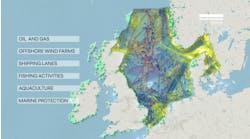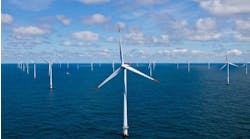Production from deep wells in the shallow-water Gulf of Mexico is one of the most promising sources for additional natural gas to help meet the near- and mid-term energy needs of the nation,the US Mineral Management Service says. Deepgas, found below 15,000 ft in less than 200 m of water, could produce as much as 20-80 MMcf/d, the government agency estimates. But gas wells that deep are expensive to drill because of high pressures and high temperatures.
In March 2003, the MMS first offered royalty relief for operators willing to drill for new and deeper prospects more than 15,000 ft below mudline (BML) on existing leases. The incentive program provides a royalty suspension on the first 15 bcf produced from a well drilled and completed between 15,000-18,000 ft BML or on the first 25 bcf from a well drilled and completed 18,000 ft or deeper BML. A royalty suspension supplement of 5 bcf, applied to future production of gas or oil from any drilling depth on that lease, is allowed for an unsuccessful well drilled to a target reservoir 18,000 ft or deeper. This dry hole incentive is aimed at helping to offset the high risk associated with drilling that deep on existing leases.
Since the initial Deep Shlef Royalty Relief program began, the MMS has added incentives to boost natural gas production and included royalty relief in new lease sales.
Operators take the risk
According to the MMS, six operators made deep gas discoveries in 2004. Energy Partners Ltd. (EPL) had the most success with three deep gas wells, and Cabot Oil and Gas Corp., Newfield Exploration Co., Spinnaker Exploration Co., Stone Energy Corp., and Walter Oil and Gas Corp. each had one.
EPL kicked off the year with a discovery in South Timbalier block 41 No. 1. The company drilled the well in 70 ft of water as a straight hole to 15,700 ft. The well encountered 60 ft of apparent pay.
EPL continued its success in June at South Timbalier block 41 with its No. 2 well. The company drilled the well in 70 ft of water to 16,679 ft TVD and logged 135 ft of apparent oil and gas pay.
At the South Timbalier block 46 No. 2 well, EPL made a discovery in October in 70 ft of water. The company drilled a straight hole to 17,716 ft and encountered 50 ft of natural gas pay in two intervals.
Cabot made a deep gas discovery in February at its Eugene Island block 280 No. 1 well. The company drilled the well to 17,470 ft and encountered 81 ft of net pay in two intervals and 114 ft of additional potential pay from 15,800-16,500 ft. The well is in 190 ft of water.
McMoRan Exploration made a significant discovery at Eugene Island block 193, 50 mi offshore Louisiana in 90 ft of water. The company drilled the deep gas well to 20,731 ft TMD and is preparing the well for completion in the Miocene sands. The well encountered five sands with a total gross interval of 340 ft, including 170 ft of new pay discovered below 19,165 ft. The company confirmed gross intervals of hydrocarbons with LWD or wireline logs. McMoRan is evaluating development options for these newly discovered hydrocarbons.
Newfield Exploration Co.’s West Cameron block 77 No. 1 well encountered 120 ft of net gas pay in two zones from 16,800-17,600 ft in 40 ft of water in July. Newfield deepened the well to 19,603 ft and encountered an additional zone. Depending on the depths of the pay section completed in this wellbore, Newfield says it will qualify for 15-25 bcf of royalty relief.
Spinnaker made a discovery at Eugene Island block 213 in 105 ft of water in May. The company drilled the well to 19,820 ft TMD and encountered 50 gross ft of potential hydrocarbon pay.
In February, Stone Energy Corp. made a discovery at South Timbalier block 166. The company drilled the well to 17,935 ft TMD in 75 ft of water and initial production flowed at 19 MMcf/d of gas and 432 b/d of condensate. The company believes that the well meets MMS regulations for royalty relief.
Walter Oil and Gas made a discovery in February at its Eugene Island block 142 No. 5 well in 48 ft of water. The company drilled the well as a straight hole to 19,316 ft and encountered over 80 ft of apparent pay in three intervals below 17,000 ft.





